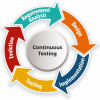Related Content
 |
A New Approach to Load Testing with Browser-Level Users Since the inception of load testing, the approach has been mostly the same: simulate the traffic of an application by creating load at the API level. But there have been market shifts that make load testing with browser-level users more feasible—allowing us to test with real load and measure true user performance. |
|
 |
Frameworks Are an Agile Leader's Best Friend With a framework in place, engineers can stop worrying about everything that framework does for them. Your team can focus on solving your business problems instead of building yet another solution to an old problem that's been solved before. Look around and identify the mistakes your team is making over and over. |
|
 |
Making Continuous Integration Work for You Many developers learn about using continuous integration to improve their deliverability speed and decrease the amount of effort needed to launch new features. Actually practicing continuous integration, however, is nowhere near as straightforward as it sounds. Here's how to get started in making CI work for you. |
|
 |
Rethink Your Strategy to Innovate Inexpensively Many companies avoid genuine innovation for fear of making potentially complex changes without producing measurable results. But you can start small with internal changes that have limited scope and that deliver prompt solutions, so there's less upfront investment—and less risk. Here's how to innovate inexpensively. |
|
 |
Continuous Testing Is Not Automation Many people confuse continuous testing with test automation. That makes sense, because you cannot do continuous testing without automated tests. But it is much more. Continuous testing has a higher-level maturity that could require a totally different way of working—but it also gives a faster path to production. |
|
 |
Implementing Continuous Delivery in the Federal Government Federal agencies generally have more regulation, slower processes, and a command-and-control style of bureaucracy. How does it work when trying to foster agility and implement a continuous delivery model? Gene Gotimer relates his experiences and challenges with encouraging a culture change in federal government. |
|
 |
3 Steps to Transformational Leadership for Business Agility Building your agile organization only starts with developing software in an agile way. The next step is transforming your business with a customer-focused embrace of agile across the entire enterprise. Managers who want a truly agile organization must lead with focus, steer from the edges, and change the system. |
|
 |
You Can’t Rush Agile Change Too often, organizations try to rush agile change. It is usually because they want to see the business benefits of agile as quickly as possible. Unfortunately, change doesn’t work like that—you can’t rush it. In fact, trying to change too fast often results in no change at all. Here are some examples to avoid. |








